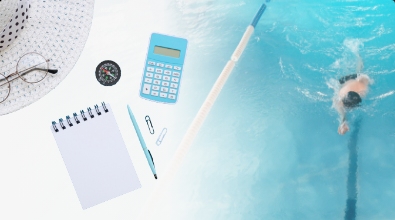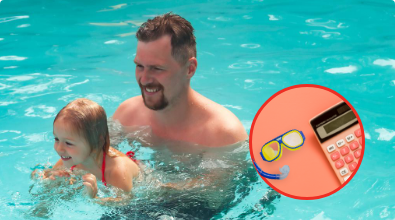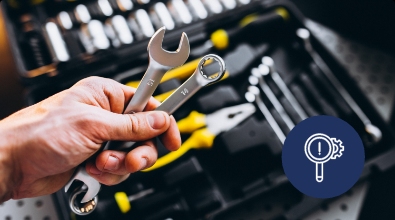Introduction to pool dehumidifier calculation.
Indoor swimming pools provide a great recreational space for families, athletes, and fitness enthusiasts. However, you need to do a proper swimming pool dehumidifier calculation and install one.
Please note maintaining a comfortable and healthy environment in an indoor pool facility is always challenging. An accurate pool dehumidification calculator can help you to select the correct sizing to counter high humidity due to the evaporation of pool water.
Failing to install a swimming pool dehumidification system can lead to various issues, such as condensation on walls and windows, mold growth, and unpleasant odors.
It also can lead to the corrosion of metal fixtures and structural damage to the building.
Investing in a swimming pool dehumidifier prevents these problems and maintains the desired humidity levels.
A pool humidity remover is an HVAC machine .. that extracts moisture from the humid air to keep your indoor pool room safe. The effectiveness of a dehumidification system entirely depends upon its capacity selection.
Hence, while using a pool dehumidifier calculator, consider factors like water temperature, room temperature, pool area, and the type of pool. An undersized unit will run continuously to achieve set humidity, while the large system can increase your equipment purchase budget and running cost.
Choosing the correct unit type and proper dehumidifier capacity selection is crucial. Based on the site, you must select one from ducted, wall mount, ceiling mount, & floor mount models.
After reading the "How to" page, you will understand dehumidifier sizing by following the step by step guide mentioned on this page.
By following these steps, you can ensure that your indoor pool environment remains comfortable and healthy for swimmers while protecting your facility from potential damage caused by excessive humidity. Read more
Step 1: Measurement for pool dehumidification calculation.
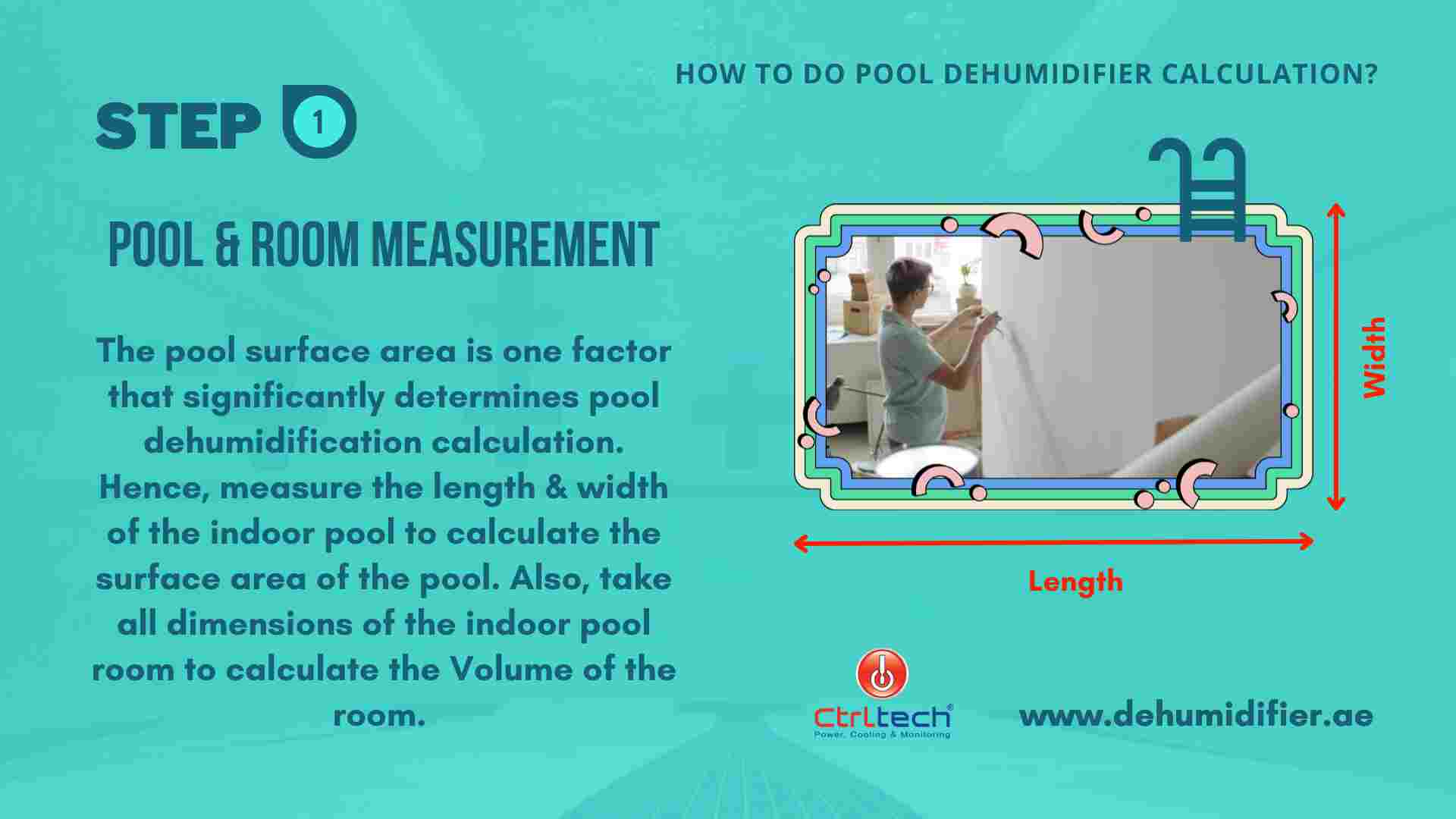
Accurate pool and pool room measurements are essential in determining the appropriate dehumidifier capacity calculation. In this step, we will explain the significance of the pool surface area and how to measure both the pool and pool room dimensions.
Pool Surface Area (A).
The pool surface area is one factor that significantly determines pool dehumidification calculation. Humidity generated by pool water evaporation and the evaporation rate are directly proportional to the pool's surface area.
A larger surface will lead to more evaporation and high humidity inside your indoor pool. Inaccurate area calculation will change the dehumidification system capacity. To measure the pool surface area, you need to take the following steps:
1. Measure the length and width of your pool with a laser distance meter. If the pool has an irregular shape, divide it into smaller, regular shapes like rectangles, squares, or triangles, and measure each section's dimensions. ..
2. Calculate the surface area of each section. For rectangles and squares pools, you can get area by simply multiplying its length by the width. For triangles, multiply the base by the height and divide by 2.
3. Add up the surface areas of all sections to get the total pool surface area.
Remember that these measurements should be in square meters to match the units used in the pool dehumidifier calculation.
Pool Room Dimensions.
A larger room will require a more powerful dehumidification machine to maintain the desired humidity levels. The pool room dimensions are also critical when selecting a dehumidifier size, as they provide an idea of the space it must effectively cover.
To measure the pool room dimensions, follow these steps:
1. Measure the length, width, and height of the pool room. If the room has an irregular shape or ceiling height, divide it into smaller, regular sections and measure each section's dimensions.
2. Calculate the volume of each section. For rectangular sections, multiply the length, width, and height.
3. Add up the volumes of all sections to get the total pool room volume.
Accurate pool and pool room measurements will help you determine the correct pool dehumidification capacity calculation for your indoor pool facility, ensuring optimal humidity control and a comfortable swimmer environment.
Read more
Step 2: Temperature reading to use in pool dehumidifier calculator.
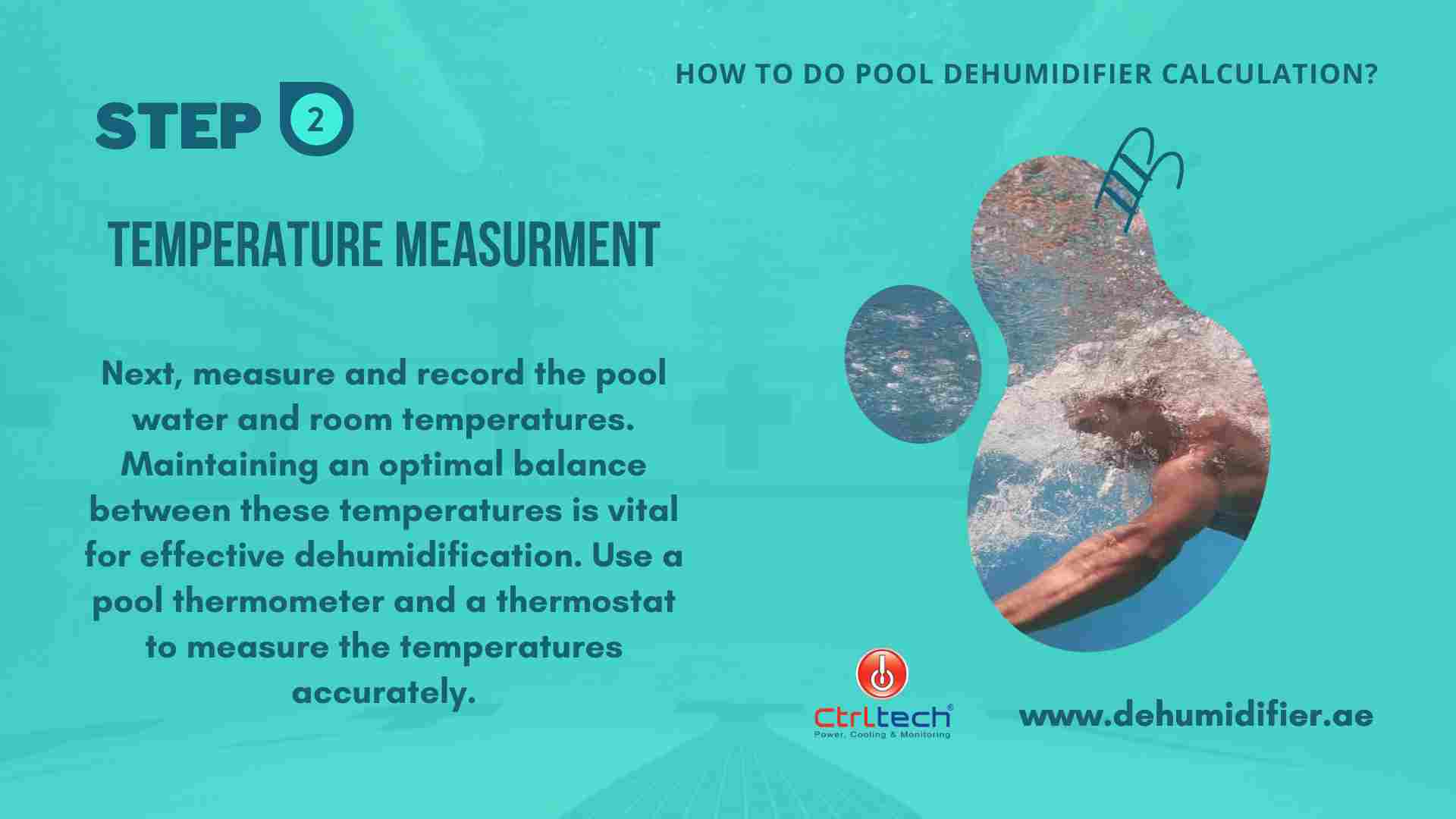
Maintaining an optimal balance between the pool water and the room temperature is vital for effective dehumidification.
In this step, we will explain the relationship between these temperatures. Also, we will study how the swimming pool dehumidifier calculation relates to temperatures.
Pool Water Temperature.
We all know that hot water evaporates at a faster rate. Hence when the power is hot, it accelerates evaporation and increases pool dehumidification calculation...
Warmer pool water will evaporate more quickly, resulting in higher humidity levels that the dehumidifier must address.
To measure the pool water temperature, you can use a pool thermometer. Record the maximum temperature the pool water can reach, which will be critical when calculating the dehumidifier capacity.
Room Temperature.
Room temperature also significantly impacts dehumidifier selection. if the room temperature is higher, it will suppress the evaporation rate. In contrast, evaporation and condensation on the walls get faster if it is lower.
Room temperature can be measured with a digital or simple calibrated thermostat. Place the thermometer away from direct sunlight, drafts, or heat sources to get an accurate reading.
Record the room temperature during the busiest hours when the indoor pool is fully occupied. It will ensure that the dehumidifier capacity selection will work even at the peak time.
As per the ASHRAE guidelines, the recommended difference between pool water and room temperature should be 1 to 2 degrees Celsius.
This difference will help prevent condensation issues and maintain a comfortable environment for swimmers. The room temperature was generally kept a little higher than the water.
By carefully measuring and recording the pool water and room temperatures, you can ensure that your dehumidifier calculator considers these critical factors, resulting in a more effective humidity control system for your indoor pool facility.
Read more
Step 3: Activity Factor (Fa) for pool dehumidifier selection.
 for pool dehumidifier selection.png)
The activity factor (Fa) is an essential component in the pool dehumidifier capacity calculation, as it accounts for the varying levels of evaporation caused by different pool types and usage patterns.
In this step, we will explain the concept of the activity factor, its significance, and how to determine the appropriate value for your pool type.
Understanding the Activity Factor.
The activity factor represents the impact of pool usage and activities on the evaporation rate. Different types of pools have varying activity levels, leading to different evaporation rates and humidity levels.
For instance, a public pool with continuous usage and a higher bather load will have a higher activity factor than a residential pool used less frequently and by fewer people.
Significance of the Activity Factor.
Incorporating the activity factor in the swimming pool dehumidifier calculation ensures that the selected unit can effectively manage the humidity levels resulting from the specific usage patterns of your pool.
This helps maintain a comfortable and healthy environment for swimmers and protects your facility from potential damage caused by excessive humidity.
Determining the Appropriate Activity Factor.
Different types of pools have other activity factors ranging from 0.1 to 1. Here's a list of activity factors for various pool types:
Residential pool: 0.10..
Condominium pool: 0.65
Therapy pool: 0.65
Hotel pool: 0.8
Public pool: 1.00
Whirlpool and spa: 1.00
To choose the appropriate activity factor for your pool, consider the purpose of the pool, its usage patterns, and the typical bather load.
The activity factor is the multiplier in pool dehumidification calculation. For instance, if you have a moderately busy hotel pool, you might select an activity factor of 0.8. If you have a residential indoor pool that is only used occasionally, you will choose a lower activity factor of 0.10.
Read more
Step 4: Calculating Saturation Pressure at the water surface (Pw) for pool dehumidifier calculation.
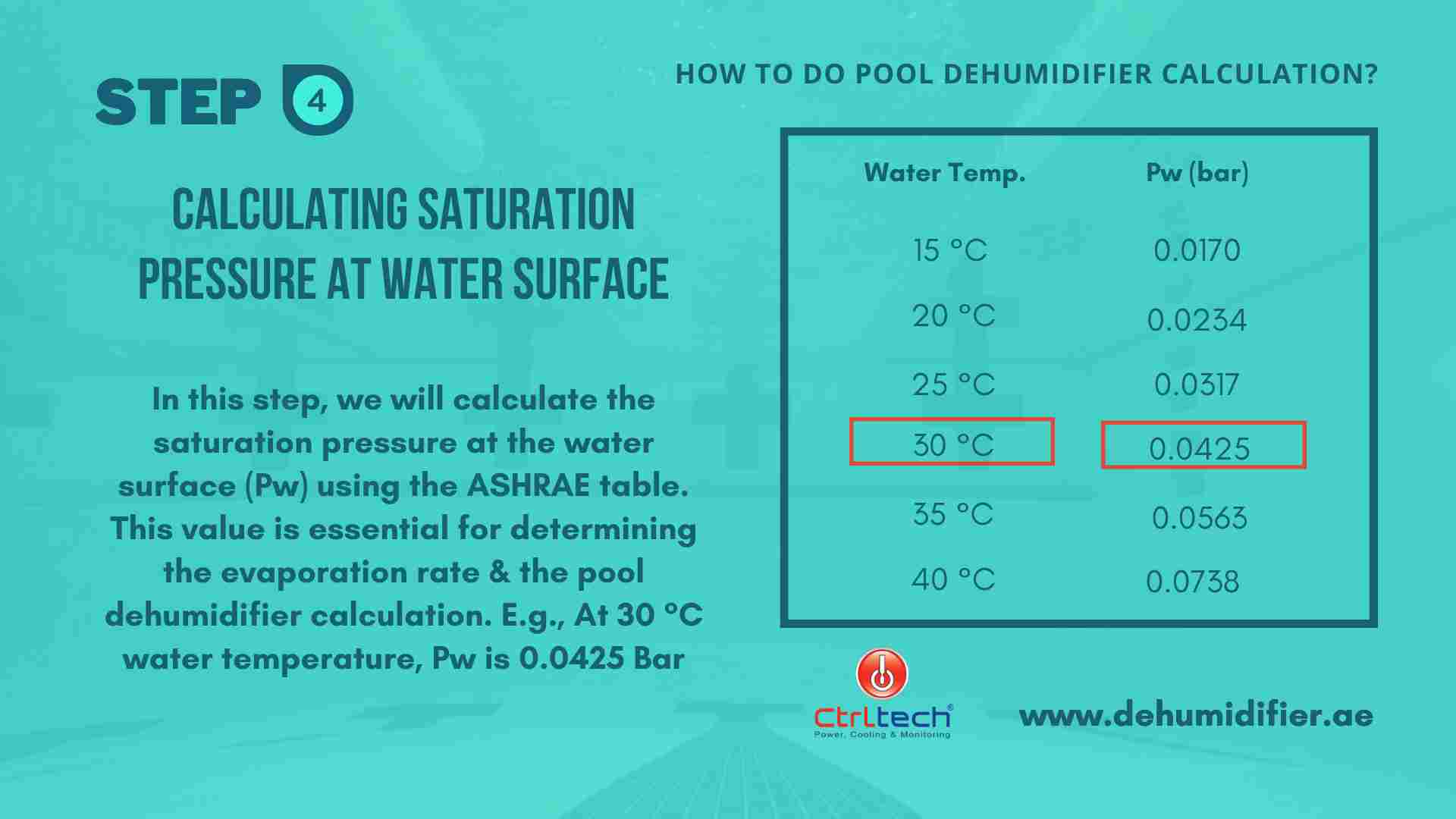
In this step, we will explain how to calculate the saturation pressure at the water surface (Pw), its significance, and how to use the ASHRAE table to find the appropriate value.
Understanding Saturation Pressure at Water Surface.
The saturation pressure at the water surface represents the pressure at which water vapor is in equilibrium with its liquid phase. In other words, it is the pressure at which the evaporation rate equals the condensation rate.
..
It is essential to find out this value correctly to determine the evaporation rate, which, in turn, pool dehumidifier calculation.
Significance of Saturation Pressure at Water Surface.
Understanding the saturation pressure at the water surface is essential for calculating the evaporation rate and, ultimately, the dehumidifier capacity.
If saturation pressure at the water surface is high, moisture air can hold at a specific temperature. It can lead to an increased evaporation rate and a more humid pool room. Thus, it will enhance pool dehumidification calculation.
Using the ASHRAE Table to Calculate Saturation Pressure at Water Surface.
To calculate the saturation pressure at the water surface, you will need to refer to the ASHRAE table, which provides saturation pressure values for various water temperatures. Follow these steps to find the appropriate value:
1. Locate the ASHRAE table for saturation pressure, which can be found in the ASHRAE Handbook or online resources.
2. Identify the row corresponding to the maximum water temperature you recorded in Step 2. The water temperature should be in degrees Celsius.
3. In the same row, find the value in the column labeled "Saturation Pressure." It is the value of saturation pressure at that water temperature.
4. Record the saturation pressure value for the final dehumidifier capacity calculation.
By calculating the saturation pressure at the water surface, you will have a crucial variable for determining the evaporation rate of your swimming pool.
This information is vital for accurately using a pool dehumidifier calculator, ensuring that your indoor pool environment remains comfortable and healthy for swimmers while protecting your facility from potential damage caused by excessive humidity.
Read more
Step 5: Saturation pressure at room air Dew Point o use in pool dehumidification calculator.
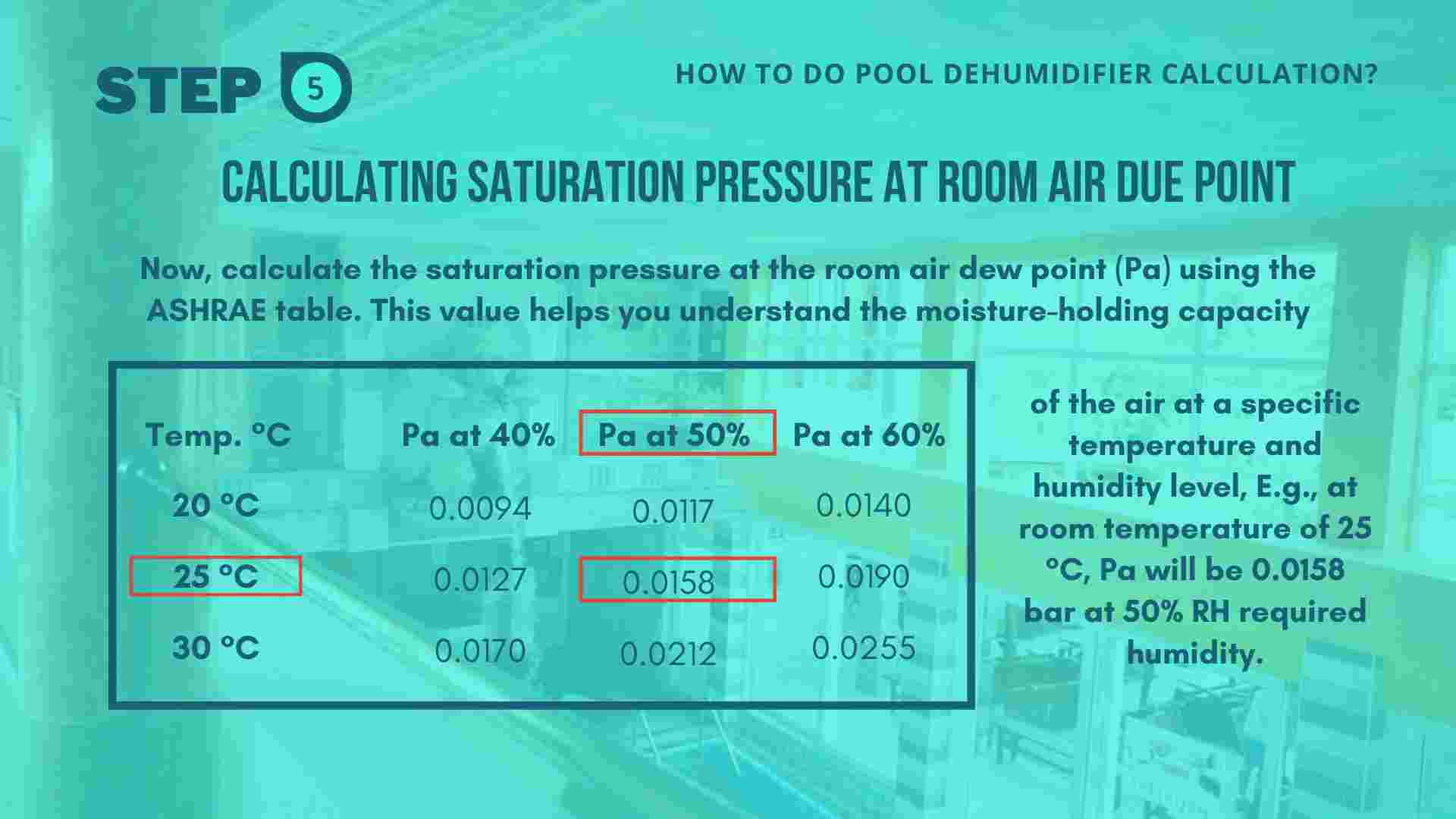
In addition to the saturation pressure at the water surface, it is vital to consider the saturation pressure at the room air dew point.
In this step, we will explain how to calculate the saturation pressure at the room air dew point and how to use the ASHRAE table to find the appropriate value to do proper pool dehumidification calculation.
This value helps you understand the moisture-holding capacity of the air at a specific temperature and humidity level.
Understanding Saturation Pressure at Room Air Dew Point.
The saturation pressure at the room air dew point represents the pressure at which the air can no longer hold any additional moisture, and condensation occurs.
..
This value is critical for understanding the moisture-holding capacity of the air at a specific temperature and humidity level. It helps to determine the appropriate dehumidifier capacity calculation.
Significance of Saturation Pressure at Room Air Dew Point.
Calculating the saturation pressure at the room air dew point allows you to determine the moisture-holding capacity of the air in your pool room.
This information is essential for accurately calculating the required dehumidifier capacity and ensuring that your indoor pool environment remains comfortable and healthy for swimmers while protecting your facility from potential damage caused by excessive humidity.
Using the ASHRAE Table to Calculate Saturation Pressure at Room Air Dew Point.
To calculate the saturation pressure at the room air dew point, you will need to refer to the ASHRAE table, which provides saturation pressure values for various temperatures and humidity levels. Follow these steps to find the appropriate value:
1. Locate the ASHRAE table for saturation pressure, which can be found in the ASHRAE Handbook or online resources.
2. Identify the row corresponding to the room temperature you recorded in Step 2. The room temperature should be in degrees Celsius.
3. Determine the desired humidity level for your pool room. This value typically ranges between 50% and 60% relative humidity.
4. Find the corresponding dew point temperature in the ASHRAE table using the room temperature and desired humidity level.
5. In the same row as the dew point temperature, find the value in the column labeled Saturation Pressure. This value represents the saturation pressure at the room air dew point for the given temperature and humidity level for swimming pool dehumidifier calculation.
6. Record the saturation pressure value for use in the final dehumidifier capacity calculation.
Read more
Step 6: Performing swimming pool dehumidifier calculation.
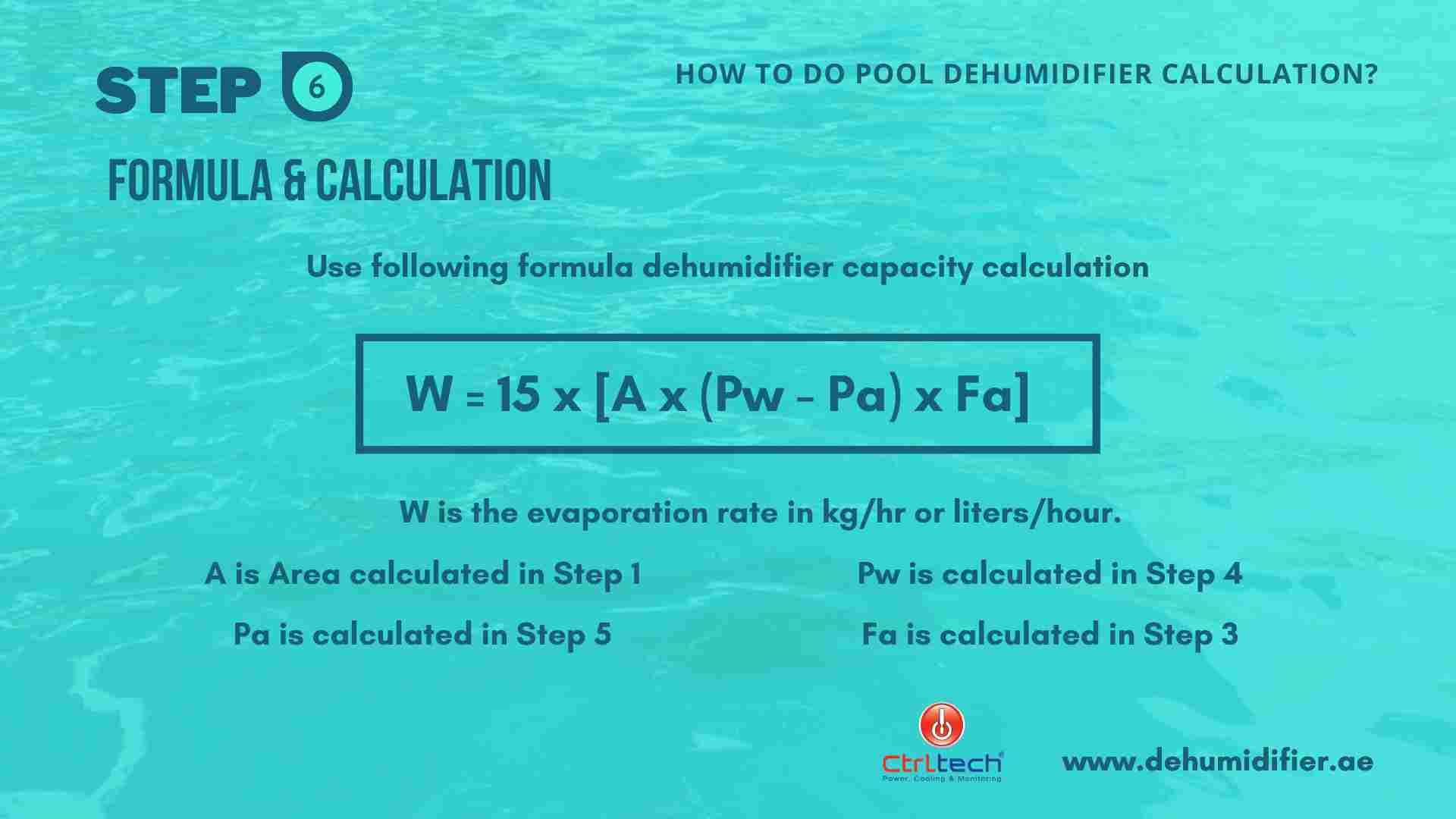
With all the necessary data gathered from the previous steps, you can now calculate the required dehumidifier capacity for your indoor pool facility. In this step, we will understand how to use the value of parameters calculated in previous steps to do pool dehumidification calculations.
The Dehumidifier Capacity Calculation Formula.
To calculate the required dehumidifier capacity, use the following formula:
W = 15 x [A x (Pw - Pa) x Fa]
Where:
W is the evaporation rate in kg/hr or liters/hour...
A represents the pool water surface area in square meters obtained from Step 1.
Pw denotes the saturation vapor pressure at the water surface temperature, obtained from Step 4.
Pa indicates the saturation pressure at the room air dew point, obtained from Step 5.
Fa is the activity factor, which depends on the type of swimming pool and is obtained from Step 3.
To perform pool dehumidification calculation, put values obtained from Steps 1, 3, 4, and 5 into the following formula to get the evaporation rate (W) in kg/hr or liters/hour.
W = 15 x [A x (Pw - Pa) x Fa]
Selecting the Appropriate Dehumidifier Capacity.
The calculated evaporation rate (W) represents the minimum dehumidification capacity required to maintain the desired humidity levels in your pool room. When choosing the unit, select equal or greater than the calculated evaporation rate.
Following the detailed pool dehumidifier calculation process outlined in this step, you can accurately determine the required dehumidifier sizing for your indoor pool facility, ensuring a comfortable and healthy environment for swimmers while protecting your facility from potential damage caused by excessive humidity.
Read more




 for pool dehumidifier selection.png)



